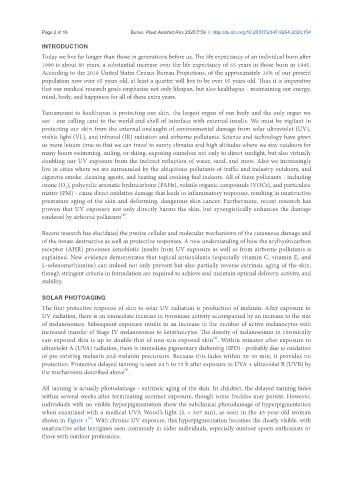Page 686 - Read Online
P. 686
Page 2 of 16 Burke. Plast Aesthet Res 2020;7:59 I http://dx.doi.org/10.20517/2347-9264.2020.154
INTRODUCTION
Today we live far longer than those in generations before us. The life expectancy of an individual born after
1990 is about 80 years, a substantial increase over the life expectancy of 65 years in those born in 1945.
According to the 2018 United States Census Bureau Projections, of the approximately 36% of our present
population now over 65 years old, at least a quarter will live to be over 95 years old. Thus it is imperative
that our medical research goals emphasize not only lifespan, but also healthspan - maintaining our energy,
mind, body, and happiness for all of these extra years.
Tantamount to healthspan is protecting our skin, the largest organ of our body and the only organ we
see - our calling card to the world and shell of interface with external insults. We must be vigilant in
protecting our skin from the external onslaught of environmental damage from solar ultraviolet (UV),
visible light (VL), and infrared (IR) radiation and airborne pollutants. Science and technology have given
us more leisure time so that we can travel to sunny climates and high altitudes where we stay outdoors for
many hours swimming, sailing, or skiing, exposing ourselves not only to direct sunlight, but also virtually
doubling our UV exposure from the indirect reflection of water, sand, and snow. Also we increasingly
live in cities where we are surrounded by the ubiquitous pollutants of traffic and industry outdoors, and
cigarette smoke, cleaning agents, and heating and cooking fuel indoors. All of these pollutants - including
ozone (O ), polycyclic aromatic hydrocarbons (PAHs), volatile organic compounds (VOCs), and particulate
3
matter (PM) - cause direct oxidative damage that leads to inflammatory responses, resulting in unattractive
premature aging of the skin and deforming, dangerous skin cancer. Furthermore, recent research has
proven that UV exposure not only directly harms the skin, but synergistically enhances the damage
[1]
rendered by airborne pollutants .
Recent research has elucidated the precise cellular and molecular mechanisms of the cutaneous damage and
of the innate destructive as well as protective responses. A new understanding of how the arylhydrocarbon
receptor (AHR) processes xenobiotic insults from UV exposure as well as from airborne pollutants is
explained. New evidence demonstrates that topical antioxidants (especially vitamin C, vitamin E, and
L-selenomethionine) can indeed not only prevent but also partially reverse extrinsic aging of the skin,
though stringent criteria in formulation are required to achieve and maintain optimal delivery, activity, and
stability.
SOLAR PHOTOAGING
The first protective response of skin to solar UV radiation is production of melanin. After exposure to
UV radiation, there is an immediate increase in tyrosinase activity accompanied by an increase in the size
of melanosomes. Subsequent exposure results in an increase in the number of active melanocytes with
increased transfer of Stage IV melanosomes to keratinocytes. The density of melanosomes in chronically
[2]
sun-exposed skin is up to double that of non-sun exposed skin . Within minutes after exposure to
ultraviolet A (UVA) radiation, there is immediate pigmentary darkening (IPD) - probably due to oxidation
of pre-existing melanin and melanin precursors. Because this fades within 20-30 min, it provides no
protection. Protective delayed tanning is seen 24 h to 72 h after exposure to UVA + ultraviolet B (UVB) by
[3]
the mechanisms described above .
All tanning is actually photodamage - extrinsic aging of the skin. In children, the delayed tanning fades
within several weeks after terminating summer exposure, though some freckles may persist. However,
individuals with no visible hyperpigmentation show the subclinical photodamage of hyperpigmentation
when examined with a medical UVA Wood’s light (λ = 367 nm), as seen in the 45-year-old woman
[3]
shown in Figure 1 . With chronic UV exposure, this hyperpigmentation becomes the clearly visible, with
unattractive solar lentigines seen commonly in older individuals, especially outdoor sports enthusiasts or
those with outdoor professions.

